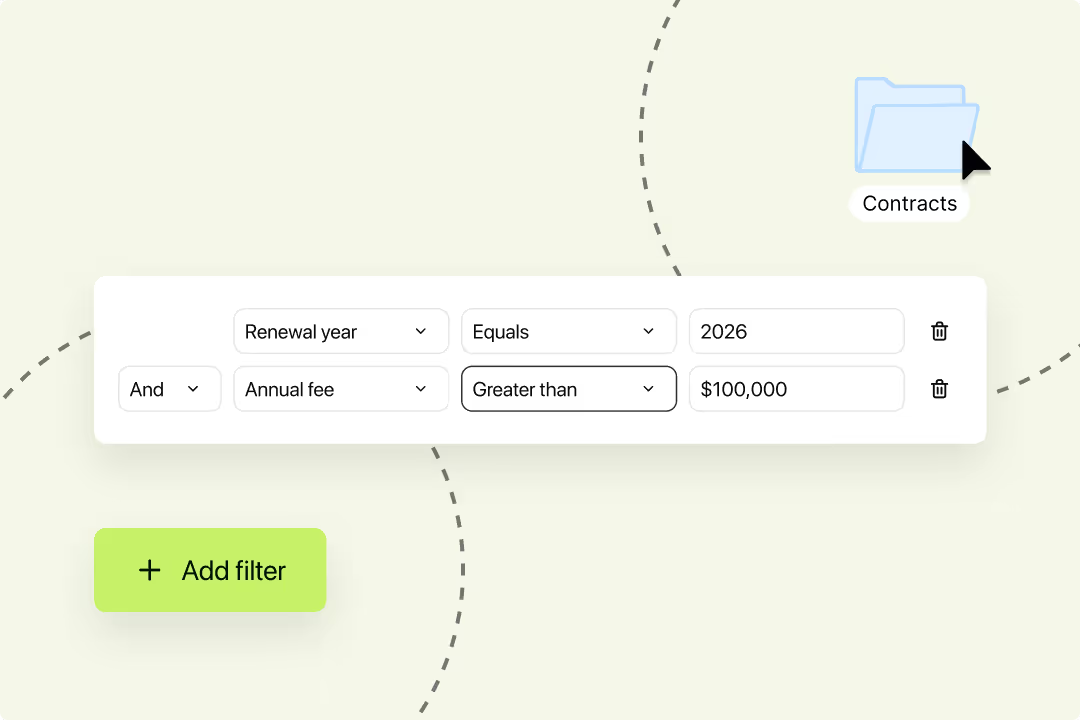Solutions
Customer Support
Resources
Many legal teams have ambitions to become data-driven, but they often don't know where to start. This guide will help you to keep a grasp on contract lifecycle management metrics in particular, exploring what you should be tracking and why.
Contract lifecycle management metrics are the numbers businesses track to determine the efficiency and success of their contract process. Performance against these metrics highlight what's working - and what isn't.
Contract lifecycle management metrics are also a useful way to benchmark what other stakeholders can expect from those managing contracts. This can lead to better alignment between legal and business teams.
The legal team are typically held accountable for performance against contract management metrics. But they aren't the only ones. Commercial teams can also find themselves contributing to a contract lifecycle management metric.
Contract value is a good example of this since it is something that go-to-market teams usually try to increase and manage. However, this can differ in different businesses, especially when resource comes into play.

When it comes to tracking contract metrics, the number of contracts you manage is one of the most obvious data points to capture.
Contract volume data can be used to inform:
You also want to track what kinds of contracts you're managing, and how the volumes vary between contract type. This gives you a good idea of the transactions you're managing and clear areas for improvement.
{{quote1}}
If you've ever heard your legal team referred to as a 'blocker', you'll probably also be familiar with the perception that contract turnaround times are too long.
Sometimes these complaints are unwarranted. Other times it can feel like a real point of friction for legal and business teams. Even when legal teams operate efficiently, there's still the possibility that large contract volumes and a lack of resource leave them buried in low-value work.
{{quote2}}
That's why it's important to track contract turnaround times. As soon as you start to track this contract metric, you can identify who may be slowing things down. Turnaround time can be broken into two main categories.
One of the most common complaints legal faces is that it’s a black hole into which business colleagues have no visibility. If someone sends a document to legal for review, did legal do anything with it? When? Did they even receive it?
Tracking your initial response time is the quickest way to resolve this complaint. A simple confirmation email acknowledging receipt goes a long way, and a track record of those acknowledgements will too.
The period between a legal team receiving a contract request and the creation of a first draft is a clear indication of efficiency. After this, the time that passes between lawyers receiving input from stakeholders, and the arrival of the final draft, is a useful benchmark.
The shorter the contract turnaround time for agreements like sales contracts, the faster the route to revenue.
"In order to create a commercial-focused mindset, the legal team should be able to identify key requirements that would help them hit targets and close deals" - Willem Wellinghoff, CCO, Ecommpay
Is contract turnaround time a problem metric for your team? With Juro, legal and business teams can agree contracts up to 10x faster than traditional tools. Hit the button below to find out more.
As your legal function becomes more mature, you might also start to track cost per transaction. This contract lifecycle management metric is a concrete way to show that legal considers the cost of contracting and finds opportunities to cut those costs.
{{quote3}}
If you’re outsourcing, then an awareness of the fully loaded cost is a fantastic tool to help you make a business case for additional headcount, or for using an ALSP for future similar transactions.
Contracts are often riddled with legal jargon. Yet, more often than not, counterparty isn't a lawyer. They could be a future employee, or a new supplier.
Not only does this technical language mean it takes longer to draft and review contracts, but it also delays getting them over the line because counterparties spend longer trying to read and digest the terms. They might even feel distrustful if you make the key points too difficult to find.
Instead, you should focus on bringing key contract data to forefront of your contracts. You should also cut out or explain unnecessary jargon and draft contracts in simple language where appropriate.
"With a bit of study and some semantic acuity, anyone who does deals can be an informed consumer of contract language" - Ken Adams, Contract language specialist
This is certainly one of the more abstract and subjective contract metrics to measure. But it is possible. If you’re working in Word, you can use the Flesch-Kincaid Grade Level to monitor your team’s improvements in simplifying contracts.
Want to increase the readability of your contracts? Check out this guide to plain language contracts.
Contract value is a metric that helps businesses to understand the financial value of a particular contract or agreement once executed. It helps organizations understand how much revenue they're closing, and what their average deal size looks like.
This contract lifecycle management metric is as much about operational capacity as it is about risk mitigation.
Some legal teams will even use contract value to determine which contracts need to be reviewed or not. Contract value thresholds can also be used to determine whether the contract needs additional clauses to help mitigate contractual or financial risk.
Being able to track the overall value of a contract also allows you to segregate your contracts into buckets: if in a given month you have ten contracts worth less than $20k, and three worth more than a million, then how would the business want you to prioritize them?

Understanding your pipeline allows you to maximize its value to the business. Of course, value is only one consideration of risk assessment, and there are many other factors that go into prioritizing legal resources, but it does serve as a very helpful objective standard for certain types of transactions.
It can be hard to measure value when it comes to contracts that aren’t defined by empirical data and dollar values. One way to handle this is to tag and categorize them during intake. However, this can be a manual, admin-heavy task if you don't use a contract lifecycle management solution like Juro.
Flagging deviations from your standard terms is always valuable as it gives you a good idea of how much contractual risk you take on as a business, and which terms create the most friction.
By identifying these problem areas or common deviations, you should be able to propose safer, more favourable terms, and remove unnecessary negotiation points.
In a high-growth SaaS environment, for example, tracking those deviations can be crucial - if reps are deviating from SLAs, or standard terms around breach notifications, then that’s critical information to track - Lucy Bassli, Legal Strategy Advisor, LawGeex
However, it's important not to get too carried away here. You can minimize contract deviations, but it's unlikely you'll be able to prevent them altogether.
Instead, focus on what’s important to your industry and keep your eye on the top four or five elements within contracts that you need to monitor. Beyond that, it can quickly get too big a task to handle. Anyone you ask will want their specific area of concern tracked, so pick wisely.
Contract renewals are another important contract management metric for businesses to track, particularly in the world of SaaS contract management.
"Auto-renewals can be a point of contention for early-stage businesses - getting locked in an expensive contract for another year is frustrating, especially if it's for a service the business is no longer using" - James Sullivan, Global General Counsel, Bitstamp
In particular, you'll want to track:
But it isn't all about the contracts you've successfully renewed. It's also about the contracts you failed to renew and the lessons learned from this. If you're experiencing a high churn rate it could be that you're overselling and underdelivering. It could also be that you're not successful in your onboarding and implementation, among other things.
Either way, it's good to keep sight of this metric, particularly as a preventative measure, rather than a reactive one.
Want tips and tricks to help you stay on top of renewals? Check out this guide to renewal management in 2026.
It's easy to overlook contractual obligations as a contract lifecycle management metric because they're such a core part of a contract and seemingly an obvious thing to track.
Yet, many businesses still don't have visibility into how many contractual obligations are either missed, outstanding or complete. This can be a risky game when it comes to contract compliance, and failing to perform your obligations under a contract can land you with costly disputes.
Businesses with greater visibility into their responsibilities and outstanding obligations can make sure contracts are completed properly, and in good time. Obligation management software is a great way to streamline the process, offering quick and easy access to the contract data you need to perform contracts properly.
Measuring contract lifecycle management metrics can raise something of a chicken-egg conundrum: do you need technology in place to get the data, or do you need the data to justify getting the technology?
What we do know is that businesses in 2026 can't afford to neglect contract lifecycle management metrics, especially when they're being pressured to achieve more with less.
We also know that contract management platforms like Juro can automate the majority of this data capture work, allowing teams to focus on the contracts themselves.

But this doesn't mean that businesses without a CLM solution in place can't track success against these metrics. It just means they will likely have to invest more time and effort into doing so. Usually, this involves a contract management spreadsheet of some sort.
What's most important is that they start.
To find out more about how Juro enables businesses like yours to improve visibility into contracts, fill in the form below.
Lorem ipsum dolor sit amet, consectetur adipiscing elit. Suspendisse varius enim in eros elementum tristique. Duis cursus, mi quis viverra ornare, eros dolor interdum nulla, ut commodo diam libero vitae erat. Aenean faucibus nibh et justo cursus id rutrum lorem imperdiet. Nunc ut sem vitae risus tristique posuere.

